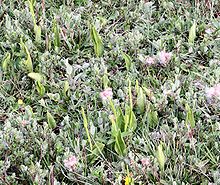bio.wikisort.org - Plant
Ophioglossum vulgatum, commonly known as adder's-tongue,[1] southern adders-tongue or adders-tongue fern, is a species of fern in the family Ophioglossaceae.[2]
The adder’s tongue fern is generally believed to have the largest number of chromosomes with 1262, compared to the human’s 46.
Distribution
It is native to many regions with a wide scattered distribution: throughout temperate through tropical Africa and throughout the temperate Northern Hemisphere in Europe, northeastern North America, temperate Asia, and Eurasia.[2][3]
This small, hard-to-spot plant can occur singly in unimproved pastures, rock crevices and grassy path-sides, but also can occur in colonies of hundreds of plants in sand dunes.[citation needed]

Description
Ophioglossum vulgatum grows from a rhizome base to 10–20 cm tall (rarely to 30 cm). It consists of a two-part frond, separated into a rounded diamond-shaped sheath and narrow spore-bearing spike. The spike has around 10-40 segments on each side.
It reproduces by means of spores.
Rarity
This species is rare in most European countries. In Ukraine, there were recorded 280 loci: 152 before 1980, after 1980 – 120, as before and after 1980 – 8 locations.[4]
Uses
Traditional European folk use of leaves and rhizomes as a poultice for wounds. This remedy was sometimes called the "Green Oil of Charity". A tea made from the leaves was used as a traditional European folk remedy for internal bleeding and vomiting.[5]
Taxonomy
Linnaeus described adder's-tongue with the binomial Ophioglossum vulgatum in his Species Plantarum of 1753.[6]
References
- Stace, Clive (2010b), New Flora of the British Isles (3rd ed.), Cambridge, UK: Cambridge University Press, ISBN 978-0-521-70772-5, p. 9
- "Ophioglossum vulgatum". Germplasm Resources Information Network (GRIN). Agricultural Research Service (ARS), United States Department of Agriculture (USDA). Retrieved 2014-02-14.
- USDA
- Parnikoza I., Celka Z. An Archive of the Ophiglossaceae in Ukraine
- Duke's Phytochemical and Ethnobotanical Databases: Ophioglossum vulgatum
- Linnaeus, C. (1753). Species Plantarum. Vol. II (1st ed.). Stockholm: Laurentii Salvii. p. 1062.
External links
На других языках
- [en] Ophioglossum vulgatum
[es] Ophioglossum vulgatum
La lengua de serpiente (Ophioglossum vulgatum) es un helecho de la familia botánica de las Ophioglossaceae. Se trata de una planta medicinal de interés como vulneraria y astringente. En la Comunidad Valenciana se considera en peligro de extinción.[ru] Ужовник обыкновенный
Ужо́вник обыкнове́нный[1] (лат. Ophioglossum vulgatum) — многолетнее травянистое растение; вид рода Ужовник (Ophioglossum) семейства Ужовниковые (Ophioglossaceae).Другой контент может иметь иную лицензию. Перед использованием материалов сайта WikiSort.org внимательно изучите правила лицензирования конкретных элементов наполнения сайта.
WikiSort.org - проект по пересортировке и дополнению контента Википедии

